Tissues are classified into two main groups, namely meristematic and permanent tissues on the basis of
whether the cells being able to divide or not.
position of the cells.
whether they are living or dead.
none of the above
Correct Answer :
A. whether the cells being able to divide or not.
Plant tissues are broadly classified on the basis of stages of development into two categories:
(i) Meristematic tissue - They have ability to divide.
(ii) Permanent tissue - They have lost the ability to divide.
Related Questions
Apical, intercalary and lateral meristems are differentiated on the basis of
origin
function
position
development
Various functions like photosynthesis, storage, excretion performed by _____________.
sclerenchyma
parenchyma
collenchyma
aerenchyma
Match the followings and choose the correct option
| Column-I | Column-II |
|---|---|
| A. Cuticle | I. Guard cells |
| B. Bulliform cells | II. Outer layer |
| C. Stomata | III. Waxy layer |
| D. Epidermis | IV. Empty colourless cell |
A III, B IV, C I, D II
A I, B II, C III, D IV
A III, B II, C IV, D I
A III, B II, C I, D IV
The length of different internodes in a culm of sugarcane is variable because of
size of leaf lamina at the node below each internode
intercalary meristem
shoot apical meristem
position of axillary buds
Which of the following process helps the trichomes in preventing water loss?
Where companion cells helps in maintaining the pressure gradient in the sieve tubes.
Where plants absorb water through the roots and then give off water vapor through pores in their leaves.
Where activity of cork cambium builds pressure on the remaining layers peripheral to phellogen and ultimately these layers dies and slough off.
None of the above
The given diagrams show stomatal apparatus in dicots and monocots. Which one is correct option for A, B and C?

A Epidermal cells; B Subsidiary cells; C chloroplast
A Guard cells; B Subsidiary cells; C Stomatal pore
A Guard cells; B Epidermal cells; C Guard cells
A Epidermal cells; B Subsidiary cells; C Guard cells
A common structural feature of vessel elements and sieve tube elements are
pores on lateral walls.
presence of p-protein.
enucleate condition.
thick secondary walls.
T.S. of dicot stem is given below, certain parts have been marked by alphabets (A I). Choose the option which shows their correct labelling.

A Epidermis, B Epidermal hair, C Parenchyma, D Starch sheath, E Hypodermis (collenchyma), F Vascular bundle, G Bundle cap, H Medulla or pith, I Medullary rays
A Epidermal hair, B Epidermis, C Hypodermis (collenchyma), D Parenchyma, E Endoderm is (Starch Sheath), F Pericycle, G Vascular bundle, H Medullary rays, I Medulla or pith
A Epidermal hair, B Epidermis, C Hypodermis (collenchyma), D Starch sheath, E Parenchyma, F Vascular bundle, G Bundle cap, H Medulla or pith, I Medullary rays
A Epidermal hair, B Epidermis, C Parenchyma, D Hypodermis (collenchyma), E Starch sheath, F Vascular bundle, G Bundle cap, H Medulla or pith, I Medullary rays
Identify the types of simple tissue indicated by A, B, C and D and their function.
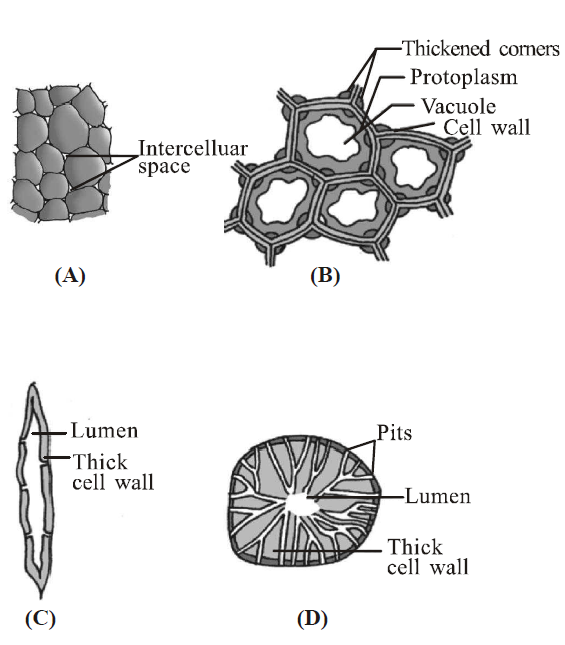
A Parenchyma, Photosynthesis, Storage and Secretion.
B Sclerenchyma Scleriods; Transport food material
C Collenchyma; Provides mechanical support to organs.
D Sclerenchyma Fibres; Provide Mechanical support to the growing parts of the plant such as young stem and petiole of a leaf.
Gymnosperms are also called soft wood spermatophytes because they lack
cambium
phloem fibres
thick-walled tracheids
xylem fibres
T.S. of monocot leaf is given below, certain parts have been marked by alphabets (A G). Which one is the option showing there correct labelling?
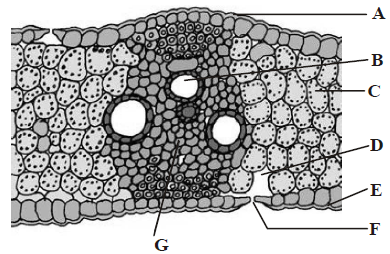
A Adaxial epidermis, B Xylem, C Mesophyll, D Sub-stomatal cavity, E Abaxial epidermis, F Stoma, G Phloem
A Adaxial epidermis, B Abaxial epidermis, C Xylem, D Sub-stomatal cavity, E Stoma, F Mesophyll, G Phloem
A Adaxial epidermis, B Phloem, C Mesophyll, D Sub-stomatal cavity, E Abaxial epidermis, F Xylem, G Stoma
A Adaxial epidermis, B Xylem, C Stoma, D Substomatal cavity, E Abaxial epidermis, F Phloem, G Mesophyll
Bast fibres are made up of _____________cells.
sclerenchymatous
chlorenchymatous
parenchymatous
aerenchymatous
Cells of permanent tissues are specialized
functionally.
only structurally.
both structurally and functionally.
for mitosis.
Lignin is the important constituent in the cell wall of
phloem
parenchyma
xylem
cambium
Which of the following pair of match is not correct?
Pith - Large and well developed in monocotyledonous root.
Root hairs - Helps in preventing water loss due to transpiration
Sieve tube elements - Its functions are controlled by the nucleus of companion cells.
Stomatal apparatus - Consists of stomatal aperture, guard cells and surrounding subsidiary cells
Tissue(s) present in an annual ring is/are
secondary xylem and phloem.
primary xylem and phloem.
secondary xylem only.
primary phloem and secondary xylem.
The given figures are types of elements (A and B) which constitute one type of complex tissue (c) of a plant . Identify A, B and C.
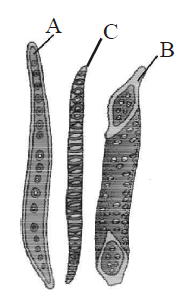
A Tracheid, B Vessel, C Xylem
A Vessel, B Tracheild, C Phloem
A Fibre, B Tracheid, C Bark
A Fibre, B Sclereid, C Casparian strips
Match the names of the structures given in column-I with the functions given in column-II, choose the answer which gives the correct combination of the two columns :
| Column-I | Column-II |
|---|---|
| (Structure) | (Function) |
| A. Stomata | I. Protection of stem |
| B. Bark | II. Plant movement |
| C. Cambium | III. Secondary growth |
| D. Cuticle | IV. Transpiration |
| V. Prevent the loss of water | ... |
A V, B III, C I, D IV
A I, B IV, C V, D III
A II, B IV, C I, D III
A IV, B I, C III, D V
In an experiment, a student cut a transverse section of young stem of a plant which he has taken from his school garden.
After observing it under the microscope how would he ascertain whether it is a monocot stem or a dicot stem?
With the help of bulliform cells.
With the help of casparian strips.
With the help of vascular bundles.
With the help of stomatal apparatus.
Which one of the following option shows the correct labelling of the parts marked as A, B, C and D in the given figure of a typical dicot root?
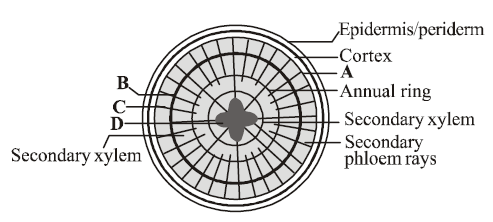
A Primary phloem, B Vascular cambium, C Secondary phloem, D Primary xylem
A Secondary phloem, B Vascular cambium, C Primary phloem, D Primary xylem
A Primary phloem, B Primary xylem, C Secondary phloem, D Vascular cambium
A Secondary phloem, B Primary xylem, C Primary phloem, D Vascular cambium
Which of the following figure is a type of permanent tissue having many different types of cell?
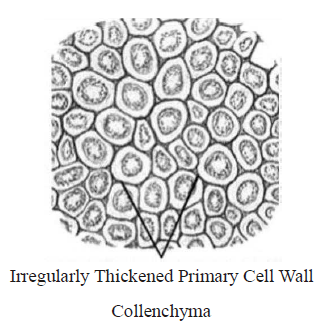
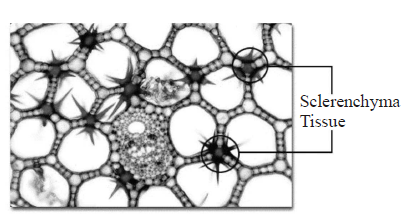
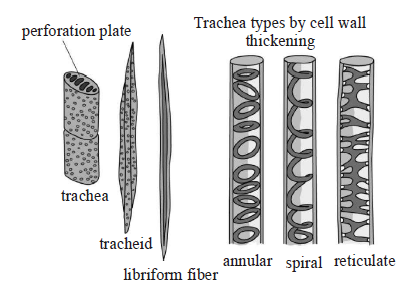
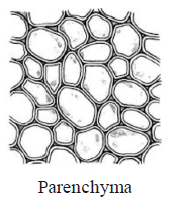
Apical and intercalary meristems are primary meristems because
they occur in the mature region of roots and shoots of many plants.
they made up of different kinds of tissues.
they involved in secondary growth.
they appear early in life of a plant and contribute to the formation of the primary plant body.
The given figure shows apical meristem of root apex with few part marked as A, B and C. Identify the correct labelling of A, B and C.
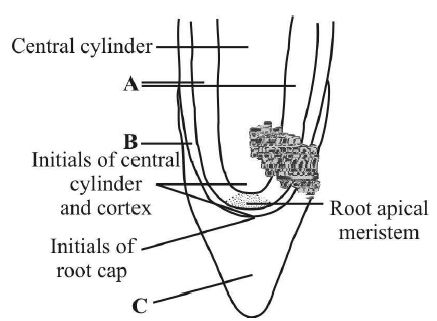
A Vascular structure, B Protoderm, C Root cap
A Cortex, B Endodermis, C Root cap
A Cortex, B Protoderm, C Root cap
A Tunica, B Protoderm, C Root cap
A vascular bundle in which the protoxylem is pointing to the periphery is called __________.
endarch
exarch
radial
closed
Main function of lenticel is
transpiration
guttation
gaseous exchange
both (a) & (c)
Why grafting is successful in dicots ?
In dicots vascular bundles are arranged in a ring.
Dicots have cambium for secondary growth.
In dicots vessels with elements are arranged end to end.
Cork cambium is present in dicots
Which of following helps bamboo and grasses to elongate ?
Apical meristems
Lateral meristems
Secondary meristems
Intercalary meristems
A student was given a tissue to observe under the microscope. He observes the tissue and concludes that the tissue is a type of simple plant tissue and provides mechanical support to young stem and petiole of leaf.
Identify the tissue.
Parenchyma
Collenchyma
Sclerenchyma
Xylem parenchyma
Which one of the following have vessels as their characteristic feature?
Angiosperms
Gymnosperms
Pteridophytes
Bryophytes
Phellogen and phellem respectively denote
cork and cork cambium,
cork cambium and cork,
secondary cortex and cork,
cork and secondary cortex,
